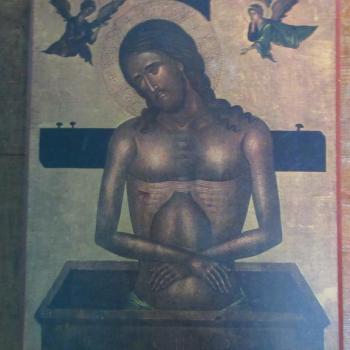When Jesus fed the multitude with five loaves and two fishes, most of us are led to ponder the miracle, to ponder how so many people could be fed by so little. Some think the miracle is that people shared what they brought with the rest of the crowd, while others think Jesus physically multiplied the loaves and fishes to make sure the populace was well fed. However, is this the right question to ask? Is this the point we are to get from this story? We are so led to read the stories as history and to ask historical questions, we ignore the broader picture. We ignore all the fine points we can learn from our holy stories.
One of the most denigrated forms of scriptural analysis today is the allegorical method of interpretation. Much can be said how it can be abused. Nonetheless, even if it can be abused, it is a time-honored and important way to read scripture, and we should at least consider how it was done in the past and what people learned from it as we consider the meaning of scripture. We should not find ourselves limited to one form of scriptural analysis, nor to one time period’s understanding of scripture. It is in this light I find St Anthony of Padua’s interpretation interesting.
The five loaves represents the five books of Moses, in which we find five refreshments for the soul. The first loaf is the rebuking of sin by contrition; the second is the laying bare of sin in confession; the third is the abasement and humiliation in satisfaction; the fourth Is zeal for souls in preaching; the fifth is the sweetness of our heavenly home in contemplation.[1]
The five loaves represent, to Anthony, the five books of Moses, but the five books of Moses, themselves, are also revealed to hold allegorical meanings. We can both see the strength and weakness of the allegorical method here. On the one hand, it allows for many parts of scripture to connect, one to another, but on another hand, it makes one wonder why these connections and points are not so succinctly put so they are easily discerned by the average reader. How, for example, does Anthony see Deuteronomy as being about the “sweetness of our heavenly home in contemplation”? He sees that Moses is given a vision of the land of promise:
Concerning the fifth loaf, we read in the fifth book, Deuteronomy, that Moses went up from the plains of Moab upon Mount Abarim, and there died before the Lord [cf. Dt 34.1,5]. Moses the penitent, should go up from the plains of Moab (‘from the father’, meaning the conversion of carnal folk, that comes from their father, the devil), to Mount Abarim (‘going over’), the excellence of contemplation, so that he may pass from this world to the Father [cf. Jn 13.1].[2]
Here, we see, the answer lies in yet another allegorical interpretation. With allegorical interpretations, one might wonder how many allegorical interpretations one needs to use until one has the meaning of the text. Perhaps the answer is that there is no limit, and this is one of the ways scripture can contain an infinite number of secrets. Indeed, there seems to be truth in this, and Anthony’s use of the meaning of names does seem to be of value for us as we try to wrestle with the meanings contained in scripture. The problem, of course, is that one seems also to have no means by which to know if one’s allegorical journey has taken a wrong turn and is leading one astray. With allegorical interpretations of scripture, one must have a living authority to declare whether or not one’s interpretations are acceptable or not, and this authority, because it existed in history, is what prevented the allegorical interpretation of scripture from becoming relativistic nonsense. In the modern era, with our distrust of authority, it is perhaps a grace that this important form of scriptural interpretation is not generally in use. This is not to say, however, we should overlook allegorical interpretations of the past; rather, we must read them and study them and learn from them, because they were made at a time when such an authority was accepted and helped keep the interpreter in check. But we must be very careful if we try to follow their example today, and do such interpretations ourselves: we must put ourselves under some authority who will be able to comment and judge our ideas, and willingly modify them if they are shown to err.
The two fishes also have their meaning, and Anthony provides the following interpretation:
The two fishes are understanding and remembrance, with which the five books of Moses should be seasoned. What you understand of the Law, you should also keep in the storehouse of your memory. Alternatively, the two fish which were brought up from the depths of the sea to the King’s table are Moses and Peter. Moses was taken from the waters, and Peter was promoted from fisherman to Apostle. The Synagogue was entrusted to Moses, the Church to Peter.[3]
Here, we find that those who follow the allegorical interpretation of scripture allow for many paths by which we can provide allegorical interpretations of a given text. This, once again, is a valuable insight, for it helps us understand that scriptural interpretation is not univocal, and that if you offer one correct interpretation, it does not prohibit other equally valuable and correct interpretations. One of the things we are so used to is to think of things as having only one value, one meaning, or, if you allow multiple meanings, each method for extracting meaning should provide only one meaning. This, however, is not the case, and Anthony helps point this out with his interpretation of the fish. Even within a given method of interpretation, one can find many meanings, each equally valid and worthwhile to ponder.
Looking to the allegorical interpretation of Scripture, and what it tells us, we find a different way of understanding the miracle of the breads and fishes. The miracle is with the multitude. The five loaves and two fishes are not what is being multiplied in history. The multitude is. We want to be in that multitude, a multitude which is understood at once to be five thousand and yet – indeterminate. It was five thousand, at one historical moment, but it continues to grow, continues to expand, so that is more than five thousand which is fed. We want to be fed by the Lord, by Christ, by the five fishes and two loaves, to have our spiritual needs met by them. Those who are joined with this multitude become the heavenly assembly before the Lord, those who receive the beatific vision.
You who are members of the Church and citizens of the heavenly Jerusalem, form this heavenly assembly, excluding the tares of discord, the madness of disobedience, the greed of simony, the leprosy of avarice and the uncleanness of lust. In this way you will be counted among the five thousand, and fed with the five loaves and two fishes, perfected with a thousand-fold perfection. May he grant this, who is blessed for ever and ever. Amen.[4]












